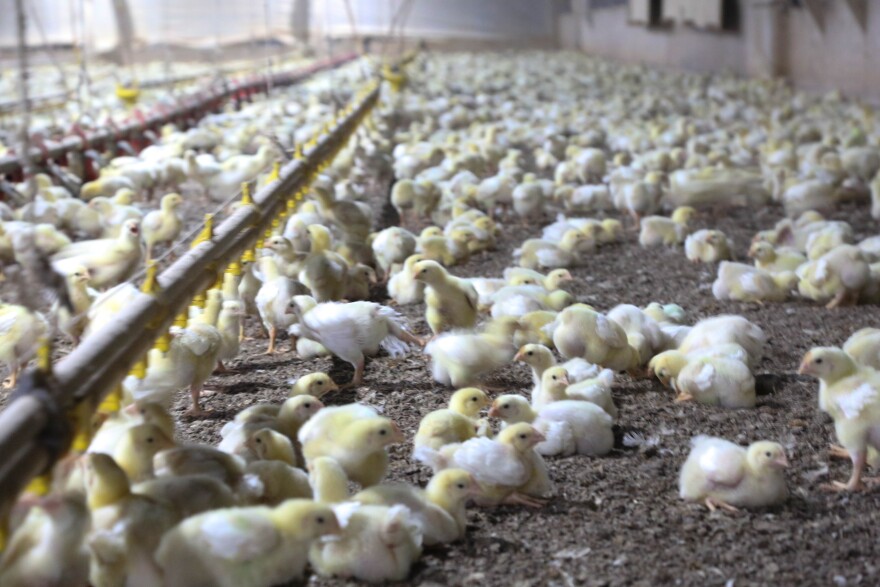Poultry is big business in Delaware and issues surrounding it - ranging from the building of new mega-chicken houses to the environmental impact of the industry - are stories we often delve into.
But in the process of that reporting, we don’t often paint a picture of what the day-to-day life of a local poultry farmer is like.
So, this week, as she works on a related story, Delaware Public Media’s Katie Peikes takes us inside a local organic chicken house to get a better feel for its operations.
From a young age, Georgie Cartanza instantly recognized the signs that pointed her in the direction of a farming career.
Her love for the outdoors and delight at the thought of cutting grass made her realize she wanted to do something that would help the agriculture industry. After pursuing a degree in general agriculture at Delaware State University, she began a career at Perdue Farms.
“I truly have been blessed because I feel like God has given me the ability to understand chickens and also help teach other people about chickens, and that’s how I ended up where I am,” Cartanza said.
And now, years later, she basks in the comfort of her own chicken farm, working as a Dover-area organic chicken grower. She describes her day-to-day tasks as fairly routine.
“Typically, I get up at 5:00 in the morning, I make sure everybody has food and water, I check the air quality,” Cartanza said.
About 148,000 organic chickens are delivered to Cartanza’s farm the day they hatch, and they’re divided between four houses.
“In organic we actually dump the chickens ourselves, so they come in on a pallet,” Cartanza said. “There’s like 13,000 chickens in 1,300 crates - there’s 100 birds in a little box, basically.”
I visited Cartanza’s farm when the chicks were just three weeks old. Now, they’re a little more mature - at almost six weeks old. The first two weeks are the most critical time for the chicks, Cartanza said.
“These are my babies - the first two weeks,” Cartanza said. “You establish a lot of things right there in the health of the bird those first two weeks.”
There’s a lot of extra attention that needs to be brought to the birds during that time, Cartanza said, especially since chicken growers are the first to make the assumption or observation that something is wrong with the birds.
From week three onward, Cartanza said the majority of her job is making sure the chicks are comfortable and healthy. It’s one of the biggest challenges of poultry growing, but she makes sure the chicks are in good shape by assessing the conditions of her houses daily.
“We’re getting rid of birds that may not be developing right. We may euthanize them,” Cartanza said. “We’re checking the drinker height, we’re looking at the feeder height, we’re looking at is there any light bulbs that are not working, are the birds sufficiently warm.”
She also checks to see if the birds need oregano or vitamins. If the birds’ droppings are loose, she runs a little bit of vinegar through a drinking system to help the birds digest their food better.
The majority of Cartanza's job is making sure the chicks are comfortable and healthy.
Along with a helper, she checks for dead birds and removes them from the house.
The chicks expand throughout a chicken house the size of two football fields end to end. When they’re first brought in, they only take up about 40 percent of the house, but week by week, they grow into it.
"And they grow out in the area until they’re seven weeks old," Cartanza said.
Once they’re seven weeks old, they start the next leg of their journey.
“All these windows will be closed up, they’ll be covered up so it’s dark in the house,” Cartanza said. “That helps keep the birds really calm. There’s a crew of people called live-haul that comes in with a forklift and cages, and they catch the birds and transport them to the processing plant, and they’re processed.”
Twenty years ago, the poultry growing industry seemed more driven by cost, Cartanza said. But the modern consumer has become more conscious about what they eat, which sparked changes in the industry as a result.
“We get a lot of outside auditing now, and it makes sure, ‘are you following your animal welfare practices?’ ‘Are you doing the things you say you’re doing?’ All those things occur to make sure we are doing what we’re supposed to be doing,” Cartanza said.
Thanks to family farmers, the chicken growing industry has a stake in Delaware, said Dan Shortridge, the former communications director with Delaware’s Department of Agriculture. Last year, Delaware’s 670 family farms produced over 240 million broiler chickens, bringing in $2.7 billion dollars. More than 4,000 people are employed in the industry.
“Our family farmers are absolutely key to this industry,” Shortridge said. “They’re the central point for these thousands of jobs. Without them, we would lose a significant part of our economy and that’s part of why we’re so determined to protect our industry both economically and from diseases.”
That includes diseases like the Avian Influenza. Delaware has not seen a major case of the fatal flu since 2004, when three forms of Low Pathogenic Avian Influenza were found on the shore, but farmers throughout the state and the Chesapeake region are still taking measures to protect their farms.




